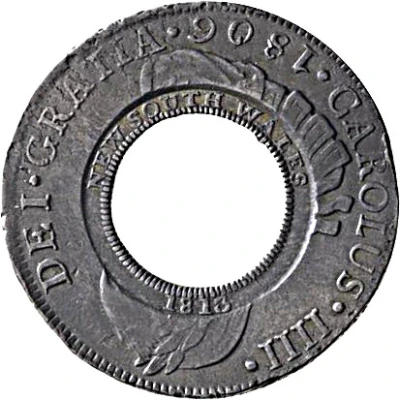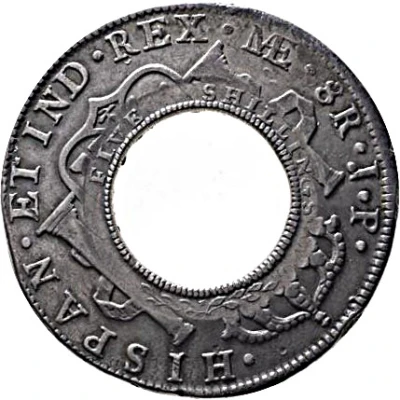


© Museum Victoria
5 Shillings - George III - Holey Dollar New South Wales Colony
1813 year| Silver (.903) | 21.035 g | 39 mm |
| Issuer | British colonies (New South Wales, Australian States) |
|---|---|
| King | George III (1760-1820) |
| Type | Standard circulation coin |
| Year | 1813 |
| Value | 5 Shillings (¼) |
| Currency | Pound sterling (1788-1900) |
| Composition | Silver (.903) |
| Weight | 21.035 g |
| Diameter | 39 mm |
| Shape | Round with a round hole |
| Technique | Milled |
| Orientation | Coin alignment ↑↓ |
| Demonetized | 1829 |
| Updated | 2024-10-04 |
| Numista | N#19811 |
|---|---|
| Rarity index | 88% |
Reverse
Around the central hole cut in the host coin, FIVE SHILLINGS together with a spray of leaves with the engraver's initial H at the centre. Around the rim of the host coin (Lima monogram). 8R . J . P. HISPAN . ET IND . REX . ; and featuring a crowned shield between pillars. Most of the shield has been removed by the holing and counterstamping
Script: Latin
Lettering:
HISPAN ET IND REX ME 8R J P
FIVE SHILLINGS
Edge
Circle & rectangle pattern
Comment
In 1813 Governor Lachlan Macquarie overcame an acute shortage of currency by arranging for the purchase of Spanish silver dollars, having the centres punched out and therein creating two new coins - the 'Holey Dollar' (valued at five shillings) and the 'Dump' (valued at one shilling and three pence). This doubled the number of coins in circulation and increased their total worth by 25 per cent. The work was carried out by William Hanshall, a convict transported for forgery.Interesting fact
One interesting fact about the 1813 Holey Dollar is that it was created as a solution to the shortage of small change in the New South Wales colony. The coin was designed with a hole in the center, which was meant to prevent it from being used as a regular coin and instead, it was used as a token for small transactions. This unique design feature made it an easily recognizable and distinctive coin in the colony.